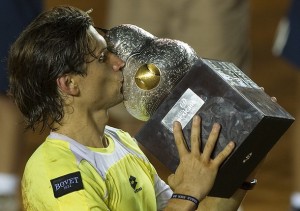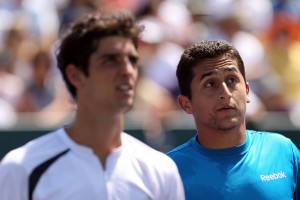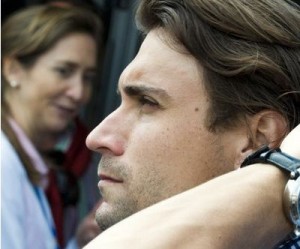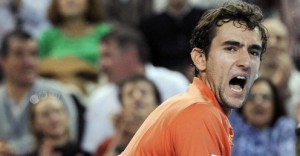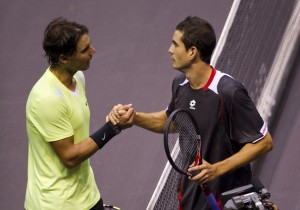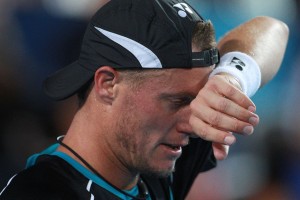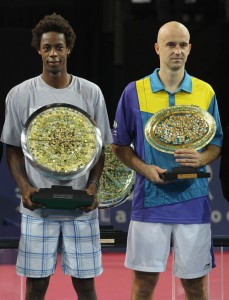Chennai 2008, Semifinal
Nadal d. Moya, 6-7 7-6 7-6
Andre Agassi’s confession in Open that he once tanked a match against Michael Chang has lately opened a sluice gate of similar accusations, levelled whenever any player loses a match they aren’t supposed to, to someone they out-rank, or to someone they’ve never lost to before. It is a sluice gate that drains directly into a sewer, from which nothing worthwhile can emerge. Hell hath no fury like a jilted idealist, and sports fans are certainly that, though hardly the worst, being mostly harmless. Generally lacking the wherewithal to employ lethal force, they instead rely upon a wearily tiny lexicon of epithets, of which ‘tanking’ is one. Thus we learn that Federer ‘tanked’ the US Open semifinal last year, so that he would not have to face Rafael Nadal in the final. The idea is self-evidently absurd. Or at least it should be, but sadly isn’t, and I’m an idealist, too.
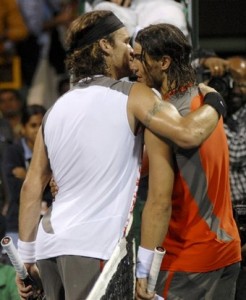 It is a brand of unearned cynicism that is really a kind of naivety, the pose with which poseurs armour themselves. Beyond that, however, it is miserably disrespectful to the players, who are just a bunch of guys doing their best at a pretty difficult task – playing pro tennis – under a great deal of pressure. It can be pointed out that they’re not out there curing cancer, and you wouldn’t be wrong. But not even the most self-important players – not even Yevgeny Kafelnikov at his worst – would claim otherwise. The worst part is that this disrespect is frequently levelled at a fan’s favourite, as a cheap balm for the hot flush of disappointment accompanying an idol’s loss. As I say, hell hath no fury . . . No players are exempt, even Rafael Nadal, despite the fact that no player has ever competed more vigorously or desperately, or shown less willingness to lose, for any reason. If more proof were needed, just watch the Chennai semifinal of 2008, in which Nadal nearly killed himself in order to deny a good friend victory in an almost meaningless event.
It is a brand of unearned cynicism that is really a kind of naivety, the pose with which poseurs armour themselves. Beyond that, however, it is miserably disrespectful to the players, who are just a bunch of guys doing their best at a pretty difficult task – playing pro tennis – under a great deal of pressure. It can be pointed out that they’re not out there curing cancer, and you wouldn’t be wrong. But not even the most self-important players – not even Yevgeny Kafelnikov at his worst – would claim otherwise. The worst part is that this disrespect is frequently levelled at a fan’s favourite, as a cheap balm for the hot flush of disappointment accompanying an idol’s loss. As I say, hell hath no fury . . . No players are exempt, even Rafael Nadal, despite the fact that no player has ever competed more vigorously or desperately, or shown less willingness to lose, for any reason. If more proof were needed, just watch the Chennai semifinal of 2008, in which Nadal nearly killed himself in order to deny a good friend victory in an almost meaningless event.
There were plenty of moments in this match at which Nadal trod a rain-slicked precipice but refused to stumble, most notably when Carlos Moya held four matchpoints in the second set tiebreak, and as Moya served for the match at 5/4 in the third. Inevitably, fortune played its part, but Nadal has never been shy about owning up to this kind of thing. Indeed, it is his very awareness that luck plays a definitive role in tennis matches that allows him to move on quickly, and never dwell on mere vagaries. He is adept at only worrying about the things under his control.
When Moya served at 6-5 in the second set tiebreaker, executed a strong point, and moved up to the net to put away a regulation volley into a fairly open court, the match was no longer in Nadal’s hands. Moya missed the volley, and Nadal was lucky. You could argue that Moya’s intimate knowledge of Nadal’s defensive capabilities – his foot speed and passing prowess – forced the elder man to go closer to the line than he otherwise might have. Perhaps that’s true, but he had acres of court available, and I myself would have been furious at at not being able to land a ball in it. Characteristically, Moya was not furious, and instead flashed a fleet, wry smile. 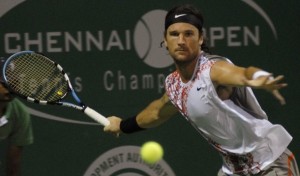 This was his cue to recede quietly into that good Indian night, but he was having none of it. He lost that second tiebreak, but he fought on, launching a dazzling array of forehands that kept Nadal’s feet and shots well shy of either baseline. Afterwards, Nadal remarked that, ‘I don’t remember the last time I saw him play so well’.
This was his cue to recede quietly into that good Indian night, but he was having none of it. He lost that second tiebreak, but he fought on, launching a dazzling array of forehands that kept Nadal’s feet and shots well shy of either baseline. Afterwards, Nadal remarked that, ‘I don’t remember the last time I saw him play so well’.
Earlier in that second set tiebreaker, serving at 1-4, there was a succinct illustration of Nadal controlling what he could. For the first time in the match, Nadal sends a second serve to Moya’s forehand, and earns an ace. Audacity when down is kind of his thing, and impossible to see coming. Some notes from the match:
- At 3 hours and 54 minutes, this match was tied at the time for the longest best of three match in ATP history. Indeed, given that the current longest match features Nadal, Novak Djokovic, and some medical time-outs, there is certainly a case to be made that the Chennai semifinal featured a lot more actual tennis.
- It is a night match, but it looks to be a brutally humid night. Nadal had nothing left in the final the following day, and fell 6/0 6/1 to Mikhail Youzhny. It probably wasn’t the most satisfying way to claim a title, but a win is a win, and it certainly beats lashing yourself around the head with a racquet.
- I’ve never seen anyone set up for their forehand the way Carlos Moya does, the way he often doesn’t bother using his left hand to position the racquet. It’s like Popeye winding up a lusty punch.
- As Moya moved to multiple matchpoints in the second set tiebreaker, the camera cuts to a little girl in the crowd. She is clearly a Nadal fan, and can muster little resilience at the prospect of her hero’s impending defeat. Wracked with sobs, she recovers slowly as the match continues, and collapses again when Moya moves ahead in the third. Her composure is a handy barometer for the match.
This little girl – who would now be about old enough to accuse her idol of tanking – is hardly the only member of the crowd who is into it. The stadium is rightfully going bananas, prompting Moya to remark later: ‘the crowd reaction was unbelievable, this is one of the things that motivates you to go on at 31 years of age.’
The full match can be downloaded here. As ever, please avoid highlights.

